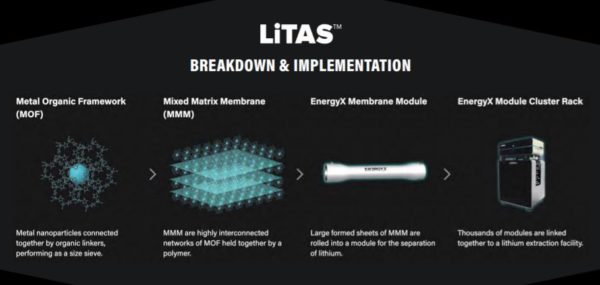In this installment of Startup Sunday, we take a look at three companies making potentially disruptive innovations in solar and energy storage.
EnergyX lithium extraction
First up, EnergyX is making its mark in the lithium extraction space by developing a technology that they said yields as much as three times as much lithium as conventional methods.
EnergyX recently secured $20 million in series A investing and has raised an additional $2.4 million through a crowd investing platform to fund its lithium-ion transport and separation technology (LiTAS.) The technology extracts lithium from brine pools using little to no water or chemicals, said EnergyX.
The LiTAS process recovers over 90% of the available lithium, enabling the cost of batteries (and ultimately the price tag on things like EVs) to be reduced significantly, said the company. Prevailing lithium extraction rates currently stand between 30-50%.

Image: EnergyX
Resource breakdown and implementation is a 1-2 day continuous process, and the company said minimal electric power is needed.
EnergyX is also building a critical component of solid state batteries, the solid electrolyte separator. The company said revenues from the LiTAS program will fund SoLiS (Solid Lithium-ion Separator) which it said is a non-flammable, highly conductive material that allows for substantial lithium metal to be present in new battery architectures, boosting battery energy density.
Edgehog solar panel glass
Montreal startup Edgehog Advanced Technologies, developer of nanotextured, omni-directional, anti-reflective glass, announced the first closing of C$1.25 million ($1 million) of its C$2.5 million ($2 million) Seed Capital raise. It supports the company’s project to scale up the size of its super-transmissive, self-cleaning solar glass.
Edgehog’s eluminar glass is made by a process that generates nano-sized textures. The company said this results in highly transmissive glass that self-cleans as water rolls off the surface. Edgehog said its antireflective glass could enhance solar panel energy generation by as much as 12%.
“Hundreds of millions of dollars have been invested to improve efficiency of solar panels but very little has been done to increase the amount of light going into solar panels,” said CEO Brad Gunn. A second financial closing is expected in the next 60 days.
Solar panel factories on the moon
In Luxembourg, Maana Electric has a vision of building shipping container-sized factories to produce solar panels from lunar sands, called regolith.

Image: David Wagman
For starters, though, the company will focus on our planet, deploying a pilot in the desert. That pilot would share about 60% of the components of the proposed lunar model. The company said its customers for now could use sand in desert landscapes to produce solar modules.
On the Moon, a similar concept would be applied but would use local resources to build panels. It would turn lunar-sourced regolith into high-purity silicon, producing about 1 MW worth per year.
The company said that a big difference between the Earth and the Moon production models is that the panel-making box will not need to factor in humidity or other atmospheric considerations on the Moon. This would allow the total structure to be lighter. And because mass is the single biggest cost driver in the space industry, limiting launch weight by sourcing lunar sands would reduce the overall cost, said Maana.
The company said this concept could also be applied to other planets. Maana’s first Earth-based pilot is expected to get under way next year.
Have a startup you’d like us to consider? Send your idea to ryan.kennedy@pv-magazine.com.
This content is protected by copyright and may not be reused. If you want to cooperate with us and would like to reuse some of our content, please contact: editors@pv-magazine.com.









A kwh of battery only has .5 lb of lithium at $5/lb at the moment so not seeing how much it can lower cost by making it cheaper, maybe $1?